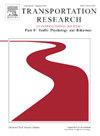The role of social perceptions on willingness-to-pay for innovations
IF 3.5
2区 工程技术
Q1 PSYCHOLOGY, APPLIED
Transportation Research Part F-Traffic Psychology and Behaviour
Pub Date : 2025-07-10
DOI:10.1016/j.trf.2025.07.008
引用次数: 0
Abstract
Innovations might be catalysts for societal progress, driving economic growth, and elevating living standards. By estimating willingness-to-pay (WTP), we can gain insight into the extent to which individuals are willing to adopt innovations. WTP studies so far have estimated individual WTP (WTPI), which refers to the amount individuals are willing to pay for an innovation. We argue that adoption is likely also affected by an individual’s perception of how much others are willing to pay, thus setting the standard, which we refer to as others’ WTP (WTPO). WTPO can affect WTPI, as people may think this is a sensible amount to pay for an innovation (cf. follow social norms). At the same time, WTPI can influence WTPO, because when individuals are not sure about what others prefer, they may rely on their own preference as a proxy. Hence, WTPI and WTPO are likely to mutually influence each other. Yet, studies have not considered the role of WTPO. We extend the literature by also accounting for WTPO in the estimation of WTP. As a case in point, we focus on WTP for automated vehicles (AVs). Results reveal that WTPI and WTPO positively influence each other. Further, we examined which factors affect WTP, and found that the overall WTP (i.e., the strength of the correlation between WTPI and WTPO) is higher among certain population segments, such as current electric vehicle users and people with a higher level of innovativeness. Interestingly, overall WTP is more strongly affected by WTPO than WTPI, indicating that the perception of how much others will be willing to pay may have a greater impact on the adoption likelihood of an innovation than the perception of our own willingness to pay.
社会观念对创新支付意愿的作用
创新可能是社会进步、推动经济增长和提高生活水平的催化剂。通过估算支付意愿(WTP),我们可以深入了解个人愿意采用创新的程度。到目前为止,WTP研究已经估算了个体WTP (WTPI),它是指个体愿意为一项创新支付的金额。我们认为,收养也可能受到个人对他人愿意支付多少钱的看法的影响,从而设定标准,我们称之为他人的WTP (WTPO)。WTPO可以影响WTPI,因为人们可能认为这是为一项创新支付的合理金额(参见遵循社会规范)。同时,WTPI可以影响WTPO,因为当个体不确定他人的偏好时,他们可能会依赖自己的偏好作为代理。因此,WTPI和WTPO可能会相互影响。然而,研究并没有考虑到世界贸易组织的作用。我们扩展了文献,在估计WTP时也考虑了WTP。作为一个恰当的例子,我们专注于自动驾驶汽车的WTP。结果表明,WTPI与WTPO正相关。进一步,我们研究了影响WTP的因素,发现在某些人群中,如当前的电动汽车用户和具有较高创新水平的人群,整体WTP(即WTPI与WTPO之间的相关性强度)更高。有趣的是,总体而言,WTP受WTPO的影响比对WTPI的影响更大,这表明其他人愿意支付多少钱的看法可能比我们自己愿意支付多少钱的看法对创新的采用可能性有更大的影响。
本文章由计算机程序翻译,如有差异,请以英文原文为准。
求助全文
约1分钟内获得全文
求助全文
来源期刊
CiteScore
7.60
自引率
14.60%
发文量
239
审稿时长
71 days
期刊介绍:
Transportation Research Part F: Traffic Psychology and Behaviour focuses on the behavioural and psychological aspects of traffic and transport. The aim of the journal is to enhance theory development, improve the quality of empirical studies and to stimulate the application of research findings in practice. TRF provides a focus and a means of communication for the considerable amount of research activities that are now being carried out in this field. The journal provides a forum for transportation researchers, psychologists, ergonomists, engineers and policy-makers with an interest in traffic and transport psychology.

 求助内容:
求助内容: 应助结果提醒方式:
应助结果提醒方式:


